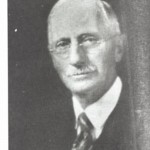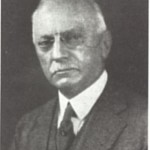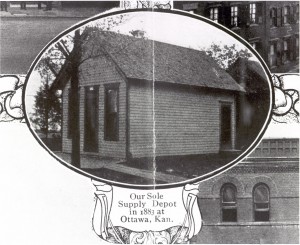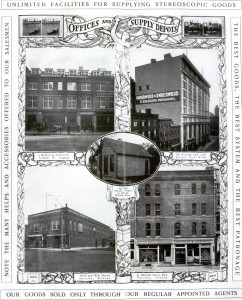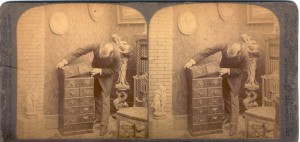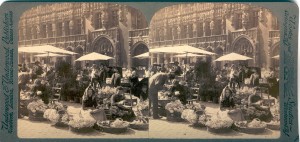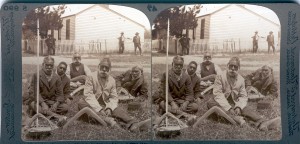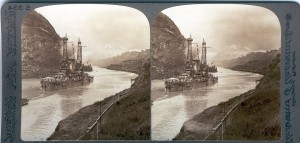Underwood & Underwood
The following information from the files of the Franklin Co. Historical Society is identified as having been furnished by E. Roy Underwood, older son of Bert Underwood. At the time, Roy lived in Summit, New Jersey. The material, written by Elmer Underwood in 1924 or ‘25 was updated in 1963 by Roy.
In June of the year 1877 two boys, Elmer and Bert Underwood, aged 17 and 15 years respectively, started west with their parents from De Kalb, Illinois, in a horse-drawn covered wagon. The most interesting items of their camp equipment in the minds of the boys were a muzzle-loading double-barreled shotgun and a setter dog. With this outfit they could hunt prairie chickens and other small game and help provide the meat en route. Other provisions were obtainable along the way at prices that are at present inconceivable. Eggs for example were purchased from the farmers at five cents a dozen. Those were the good old affluent days when a dollar had some purchasing value, when a man receiving $1.25 per day could live.
The prairie schooner trip across Illinois, Iowa and Missouri, was made in a month and Kansas, then unfenced, was entered in July. Although headed for Emporia they hesitated in that Utopian town of Ottawa, Kansas, and after remaining a few days decided to remain there, and the father rented a five room house for the family home at $8.00 per month.
The elder of the boys had already served an apprenticeship for three years in a printing office in Minnesota – had “learned the printer’s trade.” He secured a job as compositor on the Ottawa Journal, a Greenback weekly local newspaper, where he received $5.00 a week whenever the proprietor had funds enough to pay his help on Saturday nights, which was seldom. Part pay and a promise of the balance kept him on the job all summer.
The younger brother secured a job in a grocery store as boy of all work at the munificent salary of $8.00 per month.
When the fall term of school began, the boys attended—one at the Ottawa University, then a small private school. . .the other at the public school of the town. They had some schooling at Ottawa for three years, but worked on Saturdays and evenings and during school vacations.
After that both boys decided to launch out for themselves, one arranging to open a job printing office at Ottawa, Kansas, and the other becoming a book agent with Cowley County, Kansas, for his territory. In both cases their capital was very limited. The printer lad started with a borrowed $300.00, finding a partner who raised a like amount. By hard work in two years they had a country printing office paid for and were printing four regular publications besides doing the major part of the local job printing. The younger brother had filled up Cowley County with “Dr. Hall’s Health at Home,” making everybody his own doctor, and it was jokingly said that he had nearly put the physicians of that county out of business. He then undertook the sale of stereoscopic photographs and stereoscopes in the same field, succeeding so well that his brother sold his interest in the printing establishment to join him in that work.
Together these two boys considered the stereoscopic principal and its possibilities worked out selling methods and began canvassing in Missouri. Persistency and improvements in business methods brought them an increasing measure of success, and they soon secured the exclusive agency for Kansas and Missouri from the three stereoscopic publishers they had elected to patronize. These publishers, J.F. Jarvis of Washington, D.C., Charles Bierstadt of Niagara Falls and the Littleton View Company of Littleton, New Hampshire, supplied a sufficient variety of subjects, all from original negatives, with which to do business.
Stereoscopic photographs had been so cheapened that at this time those on the market were generally of a very poor quality, most of them miserable copies and not good enough to tempt customers. There were, however, a few very good original stereos being published by J.F. Jarvis of Washington, D.C.; by Charles Bierstadt of Niagara Falls; and by Littleton View Co. of Littleton, New Hampshire. The Underwood brothers under the firm name of Underwood & Underwood secured the sale of production of the three publishers named and went to work with a vim at house to house canvassing in Missouri. At the same time they secured other agents to canvass and sold the goods to all such sub-agents from their trunk stock.
Soon the volume of the sales grew to such an extent that their trunks became inadequate to carry the necessary stock. Thereupon they erected a small frame building on their father’s home lot in Ottawa at the corner of 4th and Mulberry for a shipping or distribution depot. With a payroll of one employee they managed to get along for some time.
Intuitively they sensed that success in a large way depended on volume of sales with economy of expense. They found that success was to be had only by constant energetic personal effort in promoting a plan of employing sales agents to canvass for their goods. They developed their selling plans from time to time and made it quite possible for young men with fair intelligence and energy to make a profit in house-to-house canvassing that exceed the salaries such men could command by the week or month. The business grew despite many obstacles and some strong competition.
The first five years saw Underwood & Underwood agents scattered through many states. This had necessitated a larger supply depot than the one located on West Second street. With 20 to 25 employees to care for the business that came in, they managed to supply the field from East to West from their hometown. In 1887, however, they established an additional supply depot at Baltimore, MD. to meet the needs of both their eastern and southern trade.
In 1889, the firm opened branches at Toronto, Canada, and Liverpool, Eng. To both of these countries they took a few of their best salesmen as a nucleus for starting the business, and increased their sales force locally a rapidly a possible. In 1891 they found it advisable to remove their Baltimore supply house to New York to secure better shipping facilities to Great Britain and other countries where agencies were starting. The business flourished in Great Britain. Agencies were opened in Germany, Holland, Switzerland and Scandinavia, and to better supply these the Liverpool depot was moved to London in the early part of 1892. Between 1889 and 1892 their photographers had been engaged in making stereoscopic negatives in various countries of Europe. These negatives, the property of Underwood & Underwood, were sent to America where they were transferred to the manufacturers who were supplying the firm with photos on contract. The collecting of interesting subjects was continually expanding the firm’s catalogue and made the salesmen quite happy as the expansion of variety increased their business.
A new vision of using the stereoscopic principle for educational purposes loomed when some articles by Dr. Oliver Wendell Holmes on the use and value of stereoscopic photos which had been published previously in the Atlantic Monthly were resurrected and republished in book form by Underwood & Underwood. Obsessed by the idea of making a world series by countries and arranging the subjects so that a tourist could visit these countries, they undertook to carry out the idea.
They photographed in the course of a few years the principal countries of the world and many others. They published descriptive books of the photos of each country written by an authority of his particular country, with a series of patented maps indicating the point of view and the scope of vision in each scene. This undertaking necessitated careful and painstaking photographic work. Both Elmer and Bert Underwood personally engaged extensively in photographing. They began this personal work with the camera in 1896. Together, they photographed Egypt and Palestine that year, and they continued with other countries, European and Oriental, a task of several years’ duration.
Simultaneously, they established selling agencies in various countries. They had a line of such agencies and several supply depots of their own. They operated their own house in New York, Ottawa, KS, Toronto, Canada, and in London, Paris, St. Petersburg, Bombay, Singapore, Manila and Shanghai. They also had a western supply depot in San Francisco which was destroyed by the great earthquake and fire.
In 1901, Underwood & Underwood incorporated with Bert Underwood as president, Elmer Underwood as treasurer, and C.N. Thomas, also a Kansas man, as secretary of the company. They added a lantern slide department to the business. From that time on the company did its own manufacturing with its works at Arlington, New Jersey. The firm organized a news department to supply news ph9tos to newspapers and other periodicals, which innovation was started in 1897 or 1898. It was the first illustration department organized to supply newspapers. This idea was conceived when Bert Underwood was in Greece with his camera at the time of the Greco-Turkish was. Before the declaration of war between the two countries, he had gone into Macedonia with a band of Greek insurgents and made some photographs of raids and raiders. When the war was on he, with difficulty, managed to get out of the north country and back to Athens with his negatives. Prints of these were sent to Elmer Underwood, then living in London, who made a layout of the pictures and submitted them to three illustrated weeklies in London, the Illustrated News, the Graphic, and the Black & White. The Illustrated News made the highest bid for first publication of the layout, 60 guineas, and published them. They were then sent to New York and sold to one of the daily papers there for $300. This evidences how the business of supplying photographs to newspapers got started.
The next picture the firm sold for newspaper publication was one of Queen Victoria at breakfast with two of the princesses. This was made the cover of the London Graphic and brought 12 guineas. From that time on, C.R. Abbott, then a young man in the London offices, afterwards manager of the branch, and now an officer of the company and manager of the news department of U. & U., was enthusiastically interested in the development of the photographic news business which extended around the world.
News photographs appeared constantly in periodicals throughout Europe, Asia, North and South America, South Africa, Australia, and elsewhere. Many photographers were sent out to different parts of the world to gather interesting photos of current events. These photographers got pictures in important wars. They made pictures of the Boxer Uprising, the Spanish-American War, the Boer War, the Russo-Japanese War, and U.& U. were the foremost distributors of pictures of the great World War.
. . . .The first photographs classified for schools by U.& U. were made and sold to schools in Germany. Other countries then began to use U.&.U. productions. This was done in India, Russia, Argentine and other countries. A visual instruction classification was made for schools in the United States. It was revised and improved from time to time. This proved a most effective adjunct to teaching, especially in the public schools for it is a wel known fact that a more lasting impression is made through the eye than through the ear. About two-thirds of the product of the company’s stereoscopic and lantern slide department was exported to foreign countries. Until the great World War broke out in Europe, the company had a voluminous business with those goods.
The war took practically every man from the foreign business. Without men, especially salesmen, and because was conditions made it very difficult to market photographs, all foreign business became disorganized. Every branch abroad had to be closed. In London, for example, the merchandize had to be stored, as the company was not permitted to ship it back to America because no space was allowed on merchant ships for such purposes. The company’ leases in London had to be continued but the book accounts were not collectable. Similar conditions prevailed in other countries. Even in the Far East the business went to pieces. In Singapore the stock of photographs in that comparatively small branch was packed and stored, about $200 worth at cost price. In that equatorial climate the goods in storage accumulated mold and were soon ruined. It was a total loss.
The company’s portrait studio at 417 Fifth Avenue, New York and its studio for commercial work at 6 West 39th St. in New York were doing a flourishing business, and it was thought best to expand these departments into other cities. One of the first portrait studios in America with a news department attached was opened in Washington, D.C. at 1230 Connecticut Ave, and a commercial studio with a news department was opened at 205 West Washington St. in Chicago; also a Montreal commercial branch. The remains of the stereoscopic and lantern slide business finally was sold.
These changes in the nature of the business were necessitated by the war. Conditions abroad made it impossible to reorganize the foreign business. Readjustment to meet conditions and keep up the volume had to be made. It was the company’s idea to increase its work along the portrait and commercial studio line. Its studios in New York and Washington are as fine as any in the United States, and they are turning out superb work unsurpassed anywhere. It was the ambition of U.& U. Inc. to have a chain of studios in the leading cities of the United States that would be unequalled for fine quality work.
We are told that the company has developed a new invention that bids fair to revolutionize illustration work in educational institutions, the details of which are not yet ready for announcement. The name of Underwood & Underwood of Kansas origin is and has been for many years a well-known name in all lands.
Click on Archive on the Home page to search for scans of these newspaper articles that include photographs.
